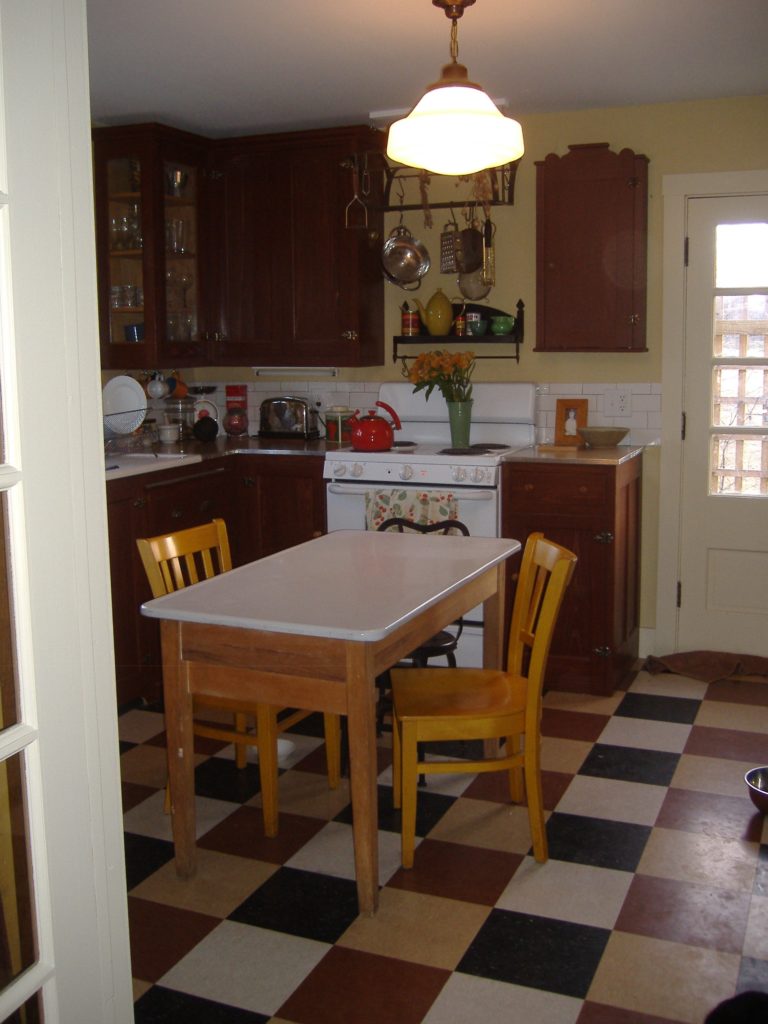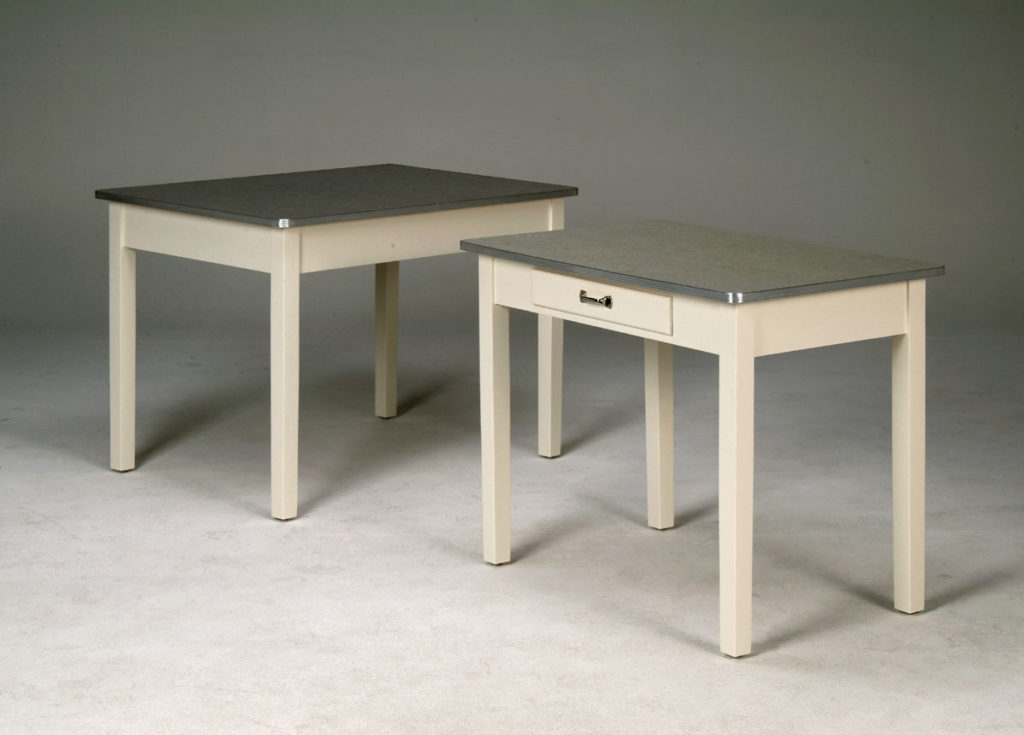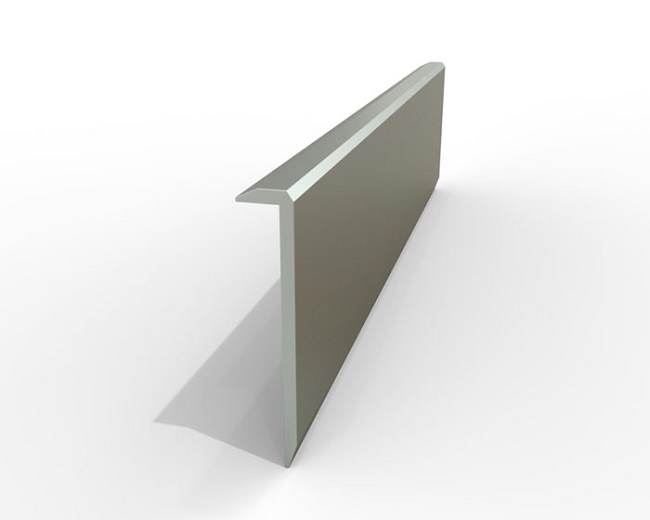We may receive a commission when you use our affiliate links. However, this does not impact our recommendations.

Kitchen with stained cypress cabinets, vinyl composition tile floor, and linoleum-topped counters
This is the first post in a series. Today we’ll have an introduction and list of the basic tools and materials you’ll need to complete a typical linoleum countertop project. Next week we’ll cover the process of prepping, adhering, trimming, and edging.
Do you need a counter solution that’s durable, handsome and affordable – one you can make yourself? Consider linoleum.
I moved into my home when it was a shell. O.S.B. subfloors, bare drywall, no interior doors, cabinets, or trim. Bare bulbs hanging from the ceiling. “Home beautiful,” indeed. I finished the interior on a shoestring, doing much of the work myself in evenings and on weekends. For months, my kitchen work surface was an old enamel-topped table. (I ate a lot of Progresso lentil soup that winter.) I gradually put together the casework for cabinets and installed them. The doors and drawers could come later; what I really wanted was a counter and a kitchen sink.
I thought about using wood for counters — I’ve used it before and loved it — but decided to go with linoleum because it’s easy to take care of and would give the kitchen a retro look that would go well with the floor and the enamel-topped table. My first memory of encountering (ouch) this solution was in graduate school, when I rented a small attic apartment in an old house. The kitchen still had a mid-century fridge (the kind with a freezer compartment that required weekly defrosting) and a fabulous old stove with fat-ringed electric elements and illuminated knobs that went from blue to green to yellow and red as you turned up the heat. The floor and counter were linoleum; the counter had a metal edge. That counter had stood up to decades of wear from renters, so I figured a similar treatment would work fine in my kitchen.

The Forbo color “Adriatica” is close to the floor in that apartment I rented during grad school.
Here’s the technique I came up with. And in case you’re wondering, the counters have been used hard for more than 12 years, surviving four rounds of renters in addition to several by me, and now my husband, too.
Tools and materials
Linoleum: Linoleum is sometimes confused with sheet vinyl, but the main feature they have in common is that each is a durable form of resilient sheet covering for floors and other surfaces. Invented in 1863, linoleum is made of linseed oil (hence the “lin-” and “oleum”), resins, cork flour, and pigments on burlap backing. If you’re interested in learning about its history and some of the amazing vintage patterns in which it was produced, check out the late Jane Powell’s book Linoleum (Gibbs-Smith, 2003).
Two brands widely available in the United States are Forbo Marmoleum and Armstrong Marmorette. Each offers a variety of patterns and colors, and their websites have technical specs, examples of their products in room settings, and suggestions for patterns you can create by cutting or inlay.
Substrate: For fixed counters and table tops I have always used high-quality veneer-core plywood. (Others may prefer other substrates, for various reasons.) Some jobs call for 3/4″ thick material, others for thicker stock. When I need more thickness, I build it up by gluing secondary layers to a top layer of 3/4″ material. If you do this, be sure to apply glue (a waterproof glue is best for any area that may be exposed to occasional splashing) uniformly and clamp thoroughly to ensure that the joints at the edges of the counter (or table top) are really solid.
When determining the thickness of the material, take into account the look you’re after, the amount of support you’re able to provide (for example, intermediate rails across the width of a long table frame, where the top could otherwise sag), and the widths of the edging material that are actually available.

A pair of the linoleum topped kitchen tables my business used to make
Edging: Whereas contemporary laminates such as Formica and Wilsonart are hard enough to be used as edging, linoleum is not. Aside from the material’s resilience (which in this respect translates to softness), it has a burlap backing, so if you tried to cut and butt join it on an edge, the burlap would be, well, in your face. There’s no reason why you can’t use solid wood as an edging, if wood suits your desired aesthetic. But traditionally, the edging for linoleum is metal. My go-to source is Eagle Mouldings. For 3/4″ counters or table tops I use their part# E-7364. The combination of substrate plus linoleum will sometimes come to just a tad more or less than the available edging. In such cases you can leave the slimmest hair of plywood edge bare at the bottom, trimming it back to keep it from being visible and from catching water or suffering from wear. If the moulding’s a little too wide, let it overhang at the bottom; just make sure it can’t catch on anything, or else it may get damaged. The most critical point is the top edge where the moulding meets the linoleum; it should ideally be flush, but if it’s not perfectly flush, it’s better to have it come up a hair over the edge rather than fall under it, because the moulding is what protects the counter’s edge. That said, if it protrudes more than a hair above the linoleum surface, it’s far more prone to being dented or even ripped off.
A number of profiles are available, some of them clean enough to create an effect that’s more modern than retro.

A clean, smooth edge can give a modern look. Just be aware that the lip at the top will come over the edge of your counter, a detail that you should factor into your design.
Adhesive and spreader: It’s best to use the specific adhesive and spreading tool recommended by the manufacturer of the linoleum you are using. Follow the instructions carefully. We’ll go through this in Part 2. As an example, Armstrong recommends this adhesive for Marmorette and recommends using a steel trowel with 1/16″ x 1/16″ x 3/32″ U-shaped notches. (All of this information is available on the manufacturer’s website if you look up the relevant product page.)
Roller: A rubber roller with a long handle will allow you to exert the necessary pressure to lay the linoleum down on the adhesive-covered substrate.
Notching tool: You only need this if you plan to round corners. For outside corners, you can miter the edging with a hacksaw and file to fit. This produces a rather sharp edge. Alternatively, you can round the substrate (then trim the linoleum to follow the radius) and bend the edging to fit. Because the moulding I use is a T-edging with a toothed section that slots into a narrow groove in the substrate’s edge, that horizontal part must be notched in order to allow the face of the moulding to go around a curve. If you don’t want to buy a special tool, you can notch with a hacksaw; you just have to be careful not to distort the face.
Router, pattern-cutting (top-mounted bearing) bit, and slot cutter: The pattern-cutting bit will be used to trim the substrate to conform to the surrounding walls, then to trim the linoleum to fit flush with the substrate. Because this last procedure dulls edges and makes a big, sticky mess, I recommend that you invest in two pattern-cutting bits: one for the plywood, the other for the linoleum. Make sure that the slot cutter you buy has a blade the correct width for the thickness of the toothed section that will fit into the slot.
Hacksaw with a fine blade for cutting the metal edging
Drill, bits, and countersink
#6 or #8 oval head slotted aluminum or nickel-plated screws
The usual measuring and safety equipment: tape measure, pencil, utility knife, straight edge, eye and ear protection, dust mask.
Have fun looking at available patterns, colors, and designs you can make up by cutting or inlaying parts. Next week we’ll get down to business.
Here are some supplies and tools we find essential in our everyday work around the shop. We may receive a commission from sales referred by our links; however, we have carefully selected these products for their usefulness and quality.









Looking forward to your next segment. I love real Lino. It’s a far better choice in many instances than PVC because the color (in good Lino) goes all the way through unlike the vinyls that have a thin pattern layer over a substrate.
Edging those round corners must be interesting.
I guess my first question would be why linoleum? Doesn’t seem durable and certainly doesn’t seem like a reviving design trend.